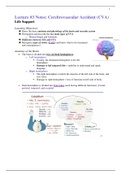Class notes
Life Support Lecture #3: Cerebrovascular Accident (CVA) and Cardiac Problems in the ER
- Course
- Institution
A two-part lecture given at Erasmus University College (EUC) about the anatomy and physiology of the brain and its vascular system; the two main types of CVA (hemorrhagic and ischemic) and their differences; the signs of stroke using the FAST method; the four types of shock and how to treat a patie...
[Show more]



